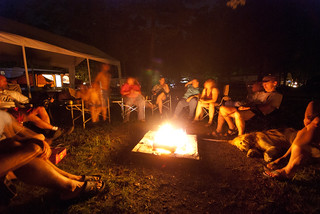I had a chance to meet Bryan Alexander at the NITLE Symposium this past April – he’s a dynamic thinker and collaborator, for sure. Up to that point, he’d been mentioned in conversations about storytelling, open access, and technology in liberal education. In conversations last semester, Alexander was mentioned as part of our digital humanities definition discussions and early conversations about digital storytelling as a learning tool.
Reading the excerpt from his book provided a window into how collaborative and social web tools can be used to illustrate stories, composition, thinking, and learning (not to mention the geekie brand of fun we all seem to enjoy). No sense in rehashing what was written in the excerpt or on the rest of Bryan’s website. You should explore that on your own. However, some key points, that I gleaned from the reading and reviewing.
The chapter defined and explained uses for various collaborative web tools like blogs, wikis, Twitter, etc. Alexander took the time to give examples of use that clearly show how people can engage high levels of learning. Something we all would like to see happening in our classes. But how?
Take a look at a lot of the learning happening in classrooms around the country. It is a lean back, consume, regurgitate experience. We are fed the information from a variety of sources, left to process it on our own, and output something similar to what was put in (i.e.: lecture and reading to PowerPoint presentation). No doubt there is learning taking place but we’re often left wanting for more both as a learner and as a teacher/faculty member.
 |
| CC BY-NC-SA: We are CS via Flickr |
Enter storytelling; more like re-enter. For centuries humans have shared stories, passed down knowledge, and created new knowledge through stories. We identify with a story and it helps us process complex events, ideas, and concepts.
Alexander suggested that we take this concept and apply it to the collaborative web or Web 2.0 (if you prefer) and challenge our own learning by processing ideas and concepts through a storyline instead of rote memorization and regurgitation.
Alexander provides an example of using a blog (a time-stamped journal on the Internet) as vehicle to re-tell the story of Dracula. Which is a series of letters that are sent and read over a period of time.
Taking Dracula as the example of using a collaborative tool to tell a story, readers can now engage the ideas and story over time as readers, but also comment, share ideas and commentary, or take the topic to a higher level and create a side story that links (freely and openly) to the main blog. Now you’ve got learners doing more than sitting back with a good book; you’ve got them leaning in with a good experience.
The collaborative web provides easy, inexpensive, and interesting ways to engage learning. How about we take science course, a elementary chemistry course, and layer in some storytelling, as an example? No doubt chemistry students need to learn equations and symbols but rather than it be a lean back absorption let’s lean our students forward and get them telling a story about the equations and reactions. Check out Periodic Videos website and see what I mean. Could we have students taking apart an equation from the work, telling a story about the chemicals, reactions, applications, or examples to help them process the information at a higher level of Bloom’s taxonomy? What then could be done if they had a higher level of understanding? Could we then back up and re-approach the equation task?
Why limit ourselves to formal (or informal) education environments? Let’s take a look at how people learn in the workplace. Could we use tools like blogs, videos, wikis, and audio to create stories for new employee orientations or new processes/products/services? A while back I wrote up a literature review about just this subject applied to Millennials – could we use the collaborative web to impact workplace training? Why not extend that further to storytelling via the collaborative web for the benefit and learning of post-graduation learners? Here’s an unedited draft.
All we’re really talking about is a centuries old technique re-imagined with Web 2.0/collaborative tools. If you prefer a more academic description – socially constructivist learning via collaborative Internet technologies.
I’d be remiss if I didn’t link you directly to Bryan Alexander’s book – The New Digital Storytelling: Creating Narratives with New Media so you can buy it and find your storytelling.
Curiosity killing cats and all, what other storytelling books do you find useful?


Add a comment